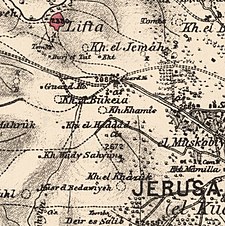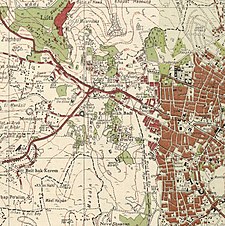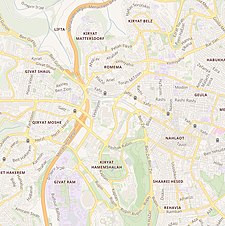Sheikh Badr
Sheikh Badr
شيخ بدر | ||
|---|---|---|
Village | ||
 Sheikh Badr house, 2008 | ||
| Etymology: from personal name[1] | ||
A series of historical maps of the area around Sheikh Badr (click the buttons) | ||
Geopolitical entity Mandatory Palestine | | |
| Subdistrict | Jerusalem | |
| Date of depopulation | January 14–19, 1948 | |
Sheikh Badr (
Location
Sheikh Badr was on a hilltop south of
The site is now occupied by the International Convention Center and the Crowne Plaza Hotel.[9]
History
Antiquity
Archaeological excavations indicate that the area of Sheikh Badr was inhabited from
Ottoman era
An
British Mandate
During the British Mandate for Palestine, Sheikh Badr was a semi-rural Arab village in western Jerusalem which benefited from its proximity to the major Jewish neighborhoods and thus increased employment opportunities.[6] The villagers grew wheat in what is now Sacher Park.[11]
During the 1947–1948 Civil War in Mandatory Palestine, the Haganah set in motion a plan to occupy (and if met with resistance, evacuate) Arab villages in order to protect nearby Jewish communities and to strengthen the Jewish hold on these sites.
State of Israel

Until 1948, Jewish burials in Jerusalem were conducted in the centuries-old Jewish cemetery on the
The Sheikh Badr cemetery functioned as a temporary burial ground from its opening on May 31, 1948, through late 1950. Unlike regular Jewish burials in Israel in which the deceased is placed directly into the grave, the deceased in Sheikh Badr were placed in wooden caskets above-ground to expedite their removal once the war ended.[15] An adjoining quarry was also used for burials; here, bodies were buried in three layers,[14] one atop the other, with a layer of dirt between each one.[15] In late 1950, approximately 300 soldiers buried in the cemetery were reinterred on Mount Herzl, and 600 civilians were reinterred on Har HaMenuchot.[15] In mid-1955, the decision was made to bury the remaining bodies in the Sheikh Badr cemetery in earth and to erect a headstone over each grave.[15]
In 1949 Sheikh Badr was incorporated into a larger area renamed Givat Ram.[4]
Notable residents
See also
- Depopulated Palestinian locations in Israel
- List of villages depopulated during the Arab-Israeli conflict
References
- ^ Palmer, 1881, p. 318
- OCLC 856647175.
- ^ a b c d Morris, 2004, p. 121
- ^ a b c d Arubas, B; Goldfus, H. "Excavations on the Site of the Jerusalem International Convention Center (Binyanei Ha'uma): The Pottery and Other Small Finds". Shelby White-Leon Levy Program for Archaeological Publications. Archived from the original on 21 May 2006. Retrieved 23 October 2012.
- ^ a b c Khalidi, 1992, p. 303
- ^ ISBN 0231106408.
- ^ Bar-Am, Aviva (10 April 2008). "Walking Tour: Authentic Romema". The Jerusalem Post. Retrieved 23 October 2012.
- ^ a b c Krystall, Nathan "The Fall of the New City 1947–1950" in Jerusalem 1948: The Arab Neighbourhoods and their Fate in the War, Salim Tamari, ed. Jerusalem: Institute for Jerusalem Studies and Badil Resource Center, 1999. Retrieved 23 October 2012.
- ^ Ruth Kark and Michal Oren-Nordheim (2001). Jerusalem and its Environs. The Hebrew University Magnus Press and Wayne State University Press. p. 151.
- ^ Socin, 1879, p. 160
- ISBN 0874518903.
- ^ "Encyclopedia of the Palestine Problem". palestine-encyclopedia.com. 1991. Archived from the original on 20 February 2012. Retrieved 23 October 2012.
- ^ Bar-Am, Aviva (31 December 2010). "The Path of Justice". The Jerusalem Post. Archived from the original on 10 June 2014. Retrieved 7 October 2012. (subscription required)
- ^ a b Samsonowitz, M. (16 October 2002). "Burial in Jerusalem: The Har Menuchos Cemetery – Part I". Dei'ah VeDibur. Archived from the original on 17 December 2015. Retrieved 7 October 2012.
- ^ a b c d Rossoff, Dovid (2005), pp. 389–390.
Bibliography
- Barron, J.B., ed. (1923). Palestine: Report and General Abstracts of the Census of 1922. Government of Palestine.
- Conder, C.R.; Kitchener, H.H. (1883). The Survey of Western Palestine: Memoirs of the Topography, Orography, Hydrography, and Archaeology. Vol. 3. London: Committee of the Palestine Exploration Fund.
- ISBN 0-88728-224-5.
- ISBN 978-0-521-00967-6.
- Palmer, E.H. (1881). The Survey of Western Palestine: Arabic and English Name Lists Collected During the Survey by Lieutenants Conder and Kitchener, R. E. Transliterated and Explained by E.H. Palmer. Committee of the Palestine Exploration Fund.
- Socin, A. (1879). "Alphabetisches Verzeichniss von Ortschaften des Paschalik Jerusalem". Zeitschrift des Deutschen Palästina-Vereins. 2: 135–163.
External links
- Welcome To al-Shaykh Badr
- Survey of Western Palestine, Map 17: IAA, Wikimedia commons





